|
|
|
Sort Order |
|
|
|
Items / Page
|
|
|
|
|
|
|
| Srl | Item |
| 1 |
ID:
130755


|
|
|
|
|
| Publication |
2014.
|
| Summary/Abstract |
Despite price-tag increases, the new Ford -class carriers won't be a boondoggle, but a boon-because ultimately, bigger = more bang for the buck.
On 9 November 2013 the nation's newest aircraft carrier, the Gerald R. Ford , was christened and blessed at a time-honored ceremony in which the hull is first wetted by the special liquid of a bottle-now champagne-to give her good luck before launching her into the water. The Ford has been built at great expense, now estimated to be $12.9 billion inclusive of design costs. Some are surprised at the price tag and argue that it is unaffordable, and that the U.S. Navy and the shipbuilder must dramatically reduce this dollar amount if we are to continue to buy and build these ships. Now that we have christened the Ford and can see her, it is a good time to review why we built her, why three administrations-two Democrat (Clinton/Obama) and one Republican (Bush-43)-as well as seven Congresses (106th-112th) have initially approved not only the Gerald R. Ford (CVN-78), but also the John F. Kennedy (CVN-79), and the Enterprise (CVN-80).
|
|
|
|
|
|
|
|
|
|
|
|
|
|
|
|
| 2 |
ID:
130751


|
|
|
|
|
| Publication |
2014.
|
| Summary/Abstract |
It is my privilege, on behalf of the board, to inform all US Naval institute members that proceeding has turned one of the most important pages in its celebrated 140 years of publication all issues.
|
|
|
|
|
|
|
|
|
|
|
|
|
|
|
|
| 3 |
ID:
130752


|
|
|
|
|
| Publication |
2014.
|
| Summary/Abstract |
As the world becomes more complex and the oceans less secure, we are compelled to strengthen the bonds of international maritime cooperation.
The United States of America maintains the largest maritime force in the world. The U.S. Navy is uniquely postured to operate forward and be ready to respond to any threat globally. This enables us to have naval forces present where it matters and when it matters. Throughout history, however, we have learned that it is almost always in the best interest of nations to act together when responding to crises, whether it involves deterrence or combat or providing humanitarian support. Accordingly, the U.S. Navy has rarely operated alone in a crisis. One of our advantages, as a nation and as a Navy, has been our extensive network of alliances, partnerships, and coalitions.
|
|
|
|
|
|
|
|
|
|
|
|
|
|
|
|
| 4 |
ID:
130757
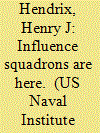

|
|
|
|
|
| Publication |
2014.
|
| Summary/Abstract |
All the components seem to be in place to make 'payloads over platforms' a reality for the Navy.
Funny thing about the future: It's dreamed about, planned for, anticipated, and then, suddenly it just shows up. Most of the time it does not occur the way it was imagined. So many factors are involved in day-to-day life for events to unfold as expected, but sometimes, perhaps with sufficient attention to the past to get a good sense of strong currents in the river of time, reasonable forecasts of near-term events can be made. Such is the case, at least partially, with the development of the Navy's shipbuilding plan and the evolution of its force structure. Whether called by name or not, influence squadrons have all but arrived.
|
|
|
|
|
|
|
|
|
|
|
|
|
|
|
|
| 5 |
ID:
130754
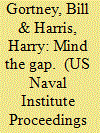

|
|
|
|
|
| Publication |
2014.
|
| Summary/Abstract |
The Readiness Kill Chain helps the Navy bridge Fleet challenges and ensure its forward-deployed forces are mission ready.
Our job as fleet commanders is to provide the United States with ready, forward-deployed naval forces. This takes concerted teamwork and many distinct partners working together toward a common goal. However, the organizations and rules responsible for developing readiness for deployable units have grown over time. The Navy originally built these entities to guide specific parts of the process but did not necessarily integrate them into the readiness production system as a whole.
|
|
|
|
|
|
|
|
|
|
|
|
|
|
|
|
| 6 |
ID:
130758
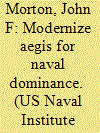

|
|
|
|
|
| Publication |
2014.
|
| Summary/Abstract |
Missile-defense capabilities on board U.S. Navy cruisers and destroyers can be updated in the future without the requirement to build new ships.
The surface Navy has a strong argument that the Department of Defense strategic guidance and the rapidly changing security environment fully support Aegis modernization plans. Modernized Aegis warships are critical naval assets for overseas commanders-even more so when cost-effectively upgraded with the capability for integrated air and missile defense (IAMD). Expedited deployment of this next-generation capability will boost near-term readiness and further solidify U.S. maritime dominance. Modernized Aegis warships are the combatant commanders' guarantors of globally integrated joint-force operations for joint access-the sharp edge of the nation's 21st-century deterrence policy.
|
|
|
|
|
|
|
|
|
|
|
|
|
|
|
|
| 7 |
ID:
130756
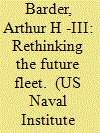

|
|
|
|
|
| Publication |
2014.
|
| Summary/Abstract |
The U.S. Navy has no overall requirements process for designing a Fleet, and it needs one-desperately.
The Navy finds itself caught in the perfect storm between the cost constraints of the national budget environment and the capability demands of globally proliferating counter-naval technologies. At present projected budget levels, if we continue our current processes for setting the design requirements of future ships and aircraft, the service's size will shrink over the next two decades to about two-thirds of today's force-structure goals of 306 ships and 3,000 aircraft. Unless we find more efficient ways to generate forward deployments out of this fleet, the Navy's forward posture-its key contribution to national strategy and joint U.S. military capability-will shrink to far less than the 100 deployed ships typically used to deliver global capability. This is not the right path.
It is time to rethink how we will design the future Fleet in a way that rebalances affordability, platform capability, and deployment processes. We must build it as a whole instead of continuing to "let it happen" one platform requirements decision at a time.
|
|
|
|
|
|
|
|
|
|
|
|
|
|
|
|
| 8 |
ID:
130753
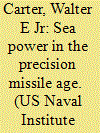

|
|
|
|
|
| Publication |
2014.
|
| Summary/Abstract |
In the hands of adversaries, long-range strike systems could drastically alter the conduct of war at sea.
The constant evolution of military technology has driven continuous change in the character of warfare, to the benefit of the militaries that adapt the most successfully. More than 70 years have passed since a major maritime conflict. During that time many new technologies have emerged, with few combat tests to provide reliable guideposts regarding what will prove successful now and in a future conflict.
|
|
|
|
|
|
|
|
|
|
|
|
|
|
|
|
| 9 |
ID:
130774


|
|
|
|
|
| Publication |
2014.
|
| Summary/Abstract |
The year 2013 brought increased challenges to the Coast Guard as the service sought to balance a declining budget with increasing operational demand. Sequestration and other budget control actions forced a $295 million cut to the service's modest $8 billion budget. In his December testimony before the House Committee on Transportation and Infrastructure, Subcommittee on Coast Guard and Maritime Transportation, Vice Admiral John Currier, the service's Vice Commandant, talked of the operational impacts of sequestration that forced the Coast Guard to reduce operations, defer depot-level maintenance, and decrease spare parts levels and training. Additionally, sequestration required a 25 percent operational reduction that affected the Coast Guard's ability to maintain an effective maritime presence to detect, deter, and intercept at-sea threats.
|
|
|
|
|
|
|
|
|
|
|
|
|
|
|
|
| 10 |
ID:
130775


|
|
|
|
|
| Publication |
2014.
|
| Summary/Abstract |
The year 2013 will go down in maritime annals as one of extraordinary contradictions, with optimism finally dislodging the melancholic recent past. This is not to imply that the maritime sector is on tranquil waters or that we are on another upswing toward record profitability similar to a decade ago. On the contrary, the recovery is still very tenuous; in fact, the highly visible container shipping market worsened last year. However, the aura of a change in the overall market trend and confidence became very noticeable toward the last quarter of 2013. And, after a gap of several decades, there are even harbingers of a domestic maritime renaissance, driven by unprecedented developments in the energy secto
|
|
|
|
|
|
|
|
|
|
|
|
|
|
|
|
| 11 |
ID:
130763
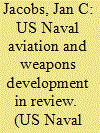

|
|
|
|
|
| Publication |
2014.
|
| Summary/Abstract |
The funding storm clouds on the horizon for the Department of Defense in 2012 came to fruition with the fiscal crisis of 2013. With Congress unable or unwilling to take action on a workable federal budget, all U.S. government agencies were required to take a cut in their funding. The resulting scramble for dollars resulted in a slowdown for the U.S. Navy in current weapon-system procurement and in establishment of new programs.
|
|
|
|
|
|
|
|
|
|
|
|
|
|
|
|
| 12 |
ID:
130759
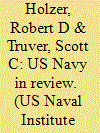

|
|
|
|
|
| Publication |
2014.
|
| Summary/Abstract |
"Over the last year, we were on station in the Pacific to deal with provocative North Korean actions," Chief of Naval Operations Admiral Jonathan Greenert wrote in his foreword to the Navy Program Guide 2014 . "We patrolled off the shores of Syria, Libya, Egypt, Somalia, and Sudan to protect American lives, hunt violent extremists, and induce regional leaders to make constructive choices amid widespread disorder. We delivered aid and relieved suffering in the Philippines in the wake of a devastating typhoon. We mobilized to restrain coercion against our allies and friends in the East and South China Seas. We kept piracy at bay in the Horn of Africa," he continued. "We projected long-range combat power from aircraft carriers in the North Arabian Sea into Afghanistan, and arrayed our forces to enhance stability in the Arabian Gulf. Across the Middle East and Africa, we took the fight to insurgents, terrorists, and their supporting networks by providing high leverage expeditionary support to Special Operations Forces."
|
|
|
|
|
|
|
|
|
|
|
|
|
|
|
|
|
|
|
|
|